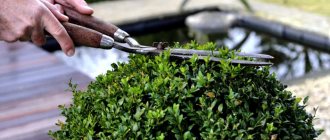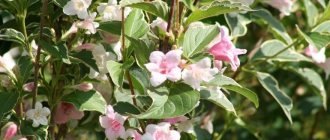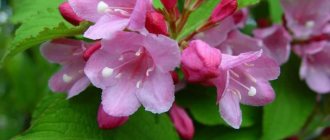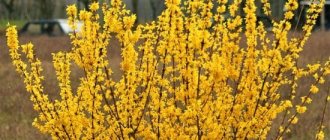Shrubs are an integral part of almost any garden plot, especially those located in the countryside. Lack of proper care can cause their uncontrolled growth. One of the ways of such care is regular trimming of branches and foliage. We will tell you how to do this correctly in our article today.
What is a hedge trimmer
A hedge trimmer is a tool for trimming and forming the correct shape of bushes and hedges. The main distinguishing feature is that hedge trimmers have powerful handles in order to apply less physical force, and elongated, sharp blades. Therefore, you can use a brush cutter for trees. There are two main types of tools: manual and mechanized. The second type, in turn, is divided into several types, depending on the power source.
Brush cutter
Haircut or trimming
These two concepts are strikingly different from each other. After all, pruning plants is a sanitary and necessary procedure designed to prepare the plant for wintering. But the haircut has a completely different focus - the aesthetic design of garden design.
To bring a decorative haircut to life, you will need certain skills, special tools (there is quite a large selection), materials and techniques.
What is a hedge trimmer for?
Manual hedge trimmer
In general, a garden hedge trimmer is a universal tool for garden care. It is used for pruning fruit and berry plantings (trees and large bushes), for trimming hedges and shaping ornamental shrubs, and for removing excess plants from a personal plot. Very often, gardeners think about whether it is possible to mow grass with a hedge trimmer. To date, several models have been created that are suitable for mowing the lawn.
Electric garden hedge trimmer
A good brush cutter makes garden care much easier, as it has a number of advantages:
- You can choose a universal unit or limit yourself to direct functionality;
- There is no need to purchase pruning shears separately, since the hedge trimmer completely replaces it and surpasses it in performance;
- The design greatly simplifies the work, since you do not need to hold the branches with your hands;
- High power allows you to cope even with large trees.
Electric garden hedge trimmer
Features of creating complex shapes
Decorative trimming of bushes includes several stages of creating a composition.
- First you need to create a wire frame of the desired shape, into which the selected plant is placed. As it grows, shoots and branches may extend beyond the frame, which must be closely monitored. All unnecessary parts are cut off even at that moment if the branches on the opposite side have not yet reached the frame.
- It may take several years for a bush to grow until it reaches a certain shape, and during this entire time it is necessary to monitor its shape and trim it from different sides. As soon as the plant reaches the shape that was intended, the wire corset is removed, and you just need to take care of the resulting figure.
- To create complex decorative figures and sculptures, stationary templates are used, which are not removed, but are connected to the plant with the help of steel rods and remain there to give it the required shape.
- To create particularly complex shapes, special fillable templates are used in which the plant develops. Most often, such structures are filled with sphagnum moss and peat, and creeping plants are planted on them, for example, most often ivy. However, creating such complex figures requires certain skills and abilities, as well as a lot of experience, since they require careful care.
How to choose a tool
Electric hedge trimmer
Choosing the right model is not an easy task. There are several types of hedge trimmers, each of which has its own characteristics and nuances:
- Brush trimmer;
- Rechargeable;
- Petrol;
- Electric;
- Manual (scissors).
Working with a hedge trimmer
How to choose a hedge trimmer for your dacha depends on some conditions:
- Area of the site and its distance from power sources;
- What type of bushes predominates in the garden (the thickness of the branches, the height of the trees and the overall girth of the crown);
- How much work remains to be done;
- Frequency of tool use;
- Who will do the work.
Manual hedge trimmer
If you plan to trim single bushes once or twice a season, then it is enough to have scissors in your arsenal. Outwardly, they look like a large pruning shears - a blade 0.25 m long and a handle of the same size. Since cutting bushes manually with a hedge trimmer is a task that requires physical effort, when choosing a model you need to focus on the convenience of the location. The handles should fit comfortably in your palms. In addition, an important characteristic is the ease of compression and release of the mechanism.
Manual hedge trimmer
Important! Wave-shaped blades work best with branches. They grip the branch tightly, so there is no need to additionally hold the bush with your hands.
Electric hedge trimmer
Garden electric shears should be chosen based on the following characteristics:
- Power - the maximum value is 0.6 kW, but for high productivity and a large volume of work on the site, 0.5 kW is sufficient;
- An effective brush cutter knife has a length of 0.4-0.5 m;
- The upper blade is made of self-sharpening material;
- The frequency of operation of the blades is an important indicator on which the evenness of the cut depends;
- For simple work, you need to take a single-sided blade. When performing figure work - double-sided;
- The configuration of the handle greatly affects ease of use, so it is important that the kit includes rubber pads.
Electric hedge trimmer
Main advantages of electric tools:
- Does not pollute the air;
- Lightweight and compact device (maximum weight – 4 kg);
- High productivity and reduced work time;
- An electric telescopic hedge trimmer is very convenient for trimming hedges;
- Models with a larger blade gap can be used as a lawn trimmer;
- The average diameter of cut branches is 2 cm.
The only drawback of this type of brush cutter is its dependence on the power source. The standard length of the wire included is 30 m. If the bushes are located further away, then you need to take care of carrying them. In addition, there is a risk of accidentally cutting the wire during operation.
Cordless hedge trimmer
A variety of electric type with an independent power source. Despite the significant advantage of mobility, such a tool has a limited charge. Therefore, you will have to constantly adjust to the duration of recharging. In addition, prolonged storage (in winter) significantly reduces the performance (capacity) of the battery, and it begins to discharge even faster. The battery weighs the device by 1.5-2 kg.
Cordless hedge trimmer
Note! A cordless hedge trimmer is best chosen for a large area, but with a small number of bushes and trees. In this case, it will be easy to move around the territory without being tied to electricity; the charge will be enough for a small amount of work. In such a situation, the device will fully justify itself.
Petrol hedge trimmer
The most powerful tool that is used in a professional environment (for trimming bushes in a forested area). A gas-powered tool requires certain skills to use. To start the engine, you need to mix oil and gasoline.
Petrol hedge trimmer
Disadvantages of this type:
- Large mass of the device (more than 5 kg);
- Exhaust into the atmosphere;
- High cost of fuel;
- High noise level;
- The need for constant maintenance.
But the power of the gas engine is enough to cut thick branches up to 5 cm (for example, thuja), as well as rough dead wood trunks. Despite the high power of such a tool, it is not advisable to purchase it for personal use. This is an option for industrial use.
Maintenance
Maintenance of brush cutters should be comprehensive and include not just maintenance of the scissors, which consists of regular inspection and sharpening. A mechanical inspection is required before and after the haircut procedure. The key to long-term operation of the trimmer without breakdowns will be maximum compliance with the manufacturer’s recommendations.
So, daily maintenance of the Stihl electric hedge trimmer and other types of trimmers from other manufacturers includes:
- Clean the outside surface of the hedge trimmer and check for visible external damage;
- Checking the throttle and its trigger latch.
- Functionality of the device instant stop button.
- Checking and cleaning the air filter.
- Checking the centering and sharpness of the cutting blade.
- Monitoring the condition of the air filter and replacing it if necessary.
- Check the trimmer head of the hedge trimmer for damage.
- Checking the degree of tightening of the locknut.
- The protective body of the hedge trimmer is correctly attached and there is no damage to it.
- Checking the degree of tension of all bolts and nuts.
Monthly maintenance also includes maintenance of the brush and motor of the electric hedge trimmer. For gasoline modifications, it is necessary to clean the fuel tank once a month. In the same way, the carburetor, fan and the area around these components are cleaned monthly.
At the same intervals, the operator should check the condition of the fuel filter and fuel line of the hedge trimmer. If necessary, they are cleaned or replaced. The clutch, its spring and drum are rated according to the degree of wear. The reliability of all connections, clamps and cables is monitored without fail.
Based on the information presented here, each user can easily use the garden hedge trimmer and maintain it during operation. Perhaps someone has valuable comments on this topic - we invite you to leave them in the comments to the material.
DIY hedge trimmer
You can make a brush cutter from a chain-type chainsaw. To do this you will need a saw, M6 hardware (nuts, bolts, washers) and a 25 mm steel strip. You need to attach knives made from steel strip to the chainsaw blade. To do this, the strip is divided into equal parts, the edges need to be cut with a grinder at an angle of 45˚. From the same strip you need to make a base on which the knives will be attached to the saw blade. It is necessary to make through holes to attach the tire with knives to the blade. The blades are welded to the bar, then this structure is bolted to the saw.
Interesting. Making a hedge cutter with your own hands from a chainsaw is quite easy if you have the necessary tools and materials. The result of the work is very high and does not differ in efficiency from purchased options.
A hedge trimmer is a must-have tool for lovers of hedges, ornamental shrubs and large gardens. It allows you to bring the crown into ideal shape, remove protruding branches, and decorate a hedge or bush in a matter of hours. It is necessary to choose a hedge trimmer based on the needs, type and number of plantings and the area being processed.
0 0 votes
Article rating
cubic bush
This figure is the most common among the decorative landscaping of the site. To create it, a frame is first made that defines the shape of the haircut.
It is represented by four racks (they can be made from reinforcement) and crossbars. The size is set individually, since the width and height of the bush can be different.
What plants are suitable for topiary?
Almost any plant can be trimmed. But there are a number of shrubs that are widely used among topiary professionals. These include:
- Boxwood. The plant is poisonous, be careful. Requires haircuts at least twice a year.
- Yew. Levels in spring and autumn.
- Holly. Due to the thorniness of the plant, it is perfect for creating a hedge or fence.
- Cotoneaster. Pliable, but requires frequent haircuts.
- Privet. The most convenient option is to cut it once a year, in warm weather.
Before you start work, take care of purchasing and sharpening the tools that you may need. Among them:
- Secateurs. Your main tool will be needed to trim branches. Choose pruners with long handles, since you will have to do some of the work at a distance from you.
- Garden knife. Use it to trim plant shoots.
- Brush cutter. Will be needed to form the crown.
- Lopper. Helps with remote pruning of branches.
- Saw. Needed for thick branches and trunks.
- Metal frame of the desired shape.
There is much disagreement regarding this last point. Professionals work exclusively with scissors. But despite this, trimming trees using a frame is now becoming more and more popular. Masters of their craft advise starting with something easy. Practice topiary art on simple shapes (circle, oval, cone) before taking on more intricate shapes.
And don’t forget that craftsmanship cannot be rushed; growing each figure will take several years. Be patient.
Safety Considerations
Hedge trimmers are very easy to use. They cut with lightning speed and precision. However, they are also potentially dangerous. This is why it is critical to always keep both hands on the trimmer and never hold a branch with one hand while trying to trim it with the trimmer. The risk of serious injury is too high.
Always be aware of those around you when using a hedge trimmer. Clear the work area of any obstructions and be aware of hoses and wires that may be hidden by hedges.
Make sure all pets and children are kept away from the area. When using an electric trimmer with a cord, always pay attention to the extension cord.
Finally, protect yourself by wearing glasses, hearing protection, work gloves, a long-sleeve shirt, pants, and short-toed shoes.
I cut everything.
If you don’t know how to trim bushes, or don’t dare to start, buy scissors and try to trim bushes that you don’t mind, gaining experience and remembering what’s what. Your first targets may be shrubs that are known to tolerate pruning well and make serious mistakes: willow, privet, bladderwort... or even ordinary currants. I would like to note that even professional gardeners, when starting a haircut, often do not know what exactly this will lead to. For example, the world-famous trimmed yew trees of the English estate “Leaves Hall” were originally trimmed in the form of hemispheres, and now, three centuries later, they turned out to be “chess pieces”. So cut everything and watch how the bushes behave. This way you will gain practical experience, which is the only thing you need in this matter. I note that in Europe the most popular objects for pruning are the very heat-loving yew and boxwood. Both of these plants suffer from frost, but to say that they are completely prohibited would be wrong. Studying their assortment, I am sure, will still lead to pleasant surprises. We will return to this at the end of this article.
Strengthening the hedge
Before attempting to create a slope for your hedge, you should outline how you want it to look. Make sure all areas of your hedge can receive sunlight. Otherwise, these areas may turn brown and die. The widest part of your hedge should always be the base.
Using the same principle with pieces of rope and wooden stakes. Move the hedge trimmer upward from the base to form a slope, gradually increasing the amount of trimming as you move toward the top.
If you are trimming older bushes, your electric hedge trimmer will not be able to cut through dense areas or thick branches.
Make sure you have a sharp pair of hand trimmers or a saw to help you get through thicker branches.
YELLOW-WHITE SHRUBS
- Kerria japonica
. No matter how much I covered this shrub, it still froze. But when I began to cut it in the fall almost at the root, then I got bright and abundant flowering. - Rowan-leaved fieldfare
. This unpretentious plant with lacy foliage can replace the fashionable but capricious palm maple. In the spring, I heavily prune the fieldfare, leaving 30 cm stumps. New powerful shoots grow very quickly, and soon delicate cream panicles bloom on them. - Forsythia
. I prune in May, after flowering. I shorten the faded shoots by half. Sometimes I thin out an old bush, cutting it to a stump, then young strong shoots appear. But if all the shoots are cut off to the stump, then the plant will not bloom next year. - Red-leaved barberry
. I planted it for its elegant foliage and bright yellow flowers. It is recommended to prune barberry every year in early spring, but I still feel sorry for it, because even without pruning it grows wildly, the bush is lush, and the flowers bloom profusely. I will do some pruning as it starts to age.
Despite the fact that its roots are topiary
decorative pruning of bushes, trees and shrubs is in its full glory
appeared in the 15th century.
It was then in France, under the reign of King Louis XV, that hedges began to decorate both Versailles itself and most gardens in Europe.
There was also a slight decline in interest in this type of art, however, today topiary is experiencing a real boom all over the world.
Not only professionals, but also ordinary amateurs who want to give their garden an individual style try to master it. Nowadays the combination of fluffy trees with clear outlines of figures is in fashion, and this look is considered exclusively British. It involves working on already grown trees and bushes.
But, despite the apparent lightness, not all tree species are suitable for creating a unique style - the main feature of the art of topiary
Gardeners who want to apply this style should pay attention to plants such as:
- Boxwood (common in gardens, although it is poisonous and requires trimming twice a year);
- Yew (similar in care to boxwood, also great for topiary);
- Holly (a thorny plant that makes a great living fence);
- Cotoneaster (allows you to create any shape, but requires frequent cutting);
- Privet (ideal for hedges, requires trimming in the warm season).
Tools required for work:
- Garden knife (needed for trimming shoots);
- Secateurs (necessary for cutting branches);
- Brush cutter (necessary for crown formation);
- Lopper (needed for remote pruning of branches);
- Saw (needed for removing thick branches).
When starting to create topiori for the first time, you should not immediately strive to make complex shapes. Experts recommend starting with simple shapes - balls, cones, ovals. But initially, of course, you should prepare a sketch of the work on paper in order to have an idea of what should happen in the final result. You should also make sure that the garden shears - the main tool for creating topiori - are sharp.
During preparatory work (if there are no necessary plants on the site), a row of juniper or spruce trees should also be planted. This is done in early spring or autumn. The distance between the trees should be approximately 80 cm. Over the course of a year, the plants will grow, and on them you can test your own strength in cutting the simplest shape.
If you want to create a more complicated option, you should get frames made of steel rods. They are a relatively new introduction to the creation of topiori, since until now the main tool of all masters is only scissors, but they can help achieve the desired result without any problems
It is important for gardeners to understand that it will take many years to create a green figure of complex geometric shape, however, the end result will delight and surprise with its perfection
Cylindrical shape
The basis for the shape of the green columns is a circle. For the frame, guides located in parallel are used. The wire forms two circles, bottom and top. It's worth moving from top to bottom. Don’t forget to constantly monitor the results and make timely adjustments.
Having mastered simpler figures, you can move on to creating complex ones. So, a column or cone is taken as the basis for forming a spiral. After improving your skills, you may want to try your hand at creating original animal figures.
Many people have a desire to give their site individuality. Beautifully designed green spaces will emphasize neatness and taste. The process itself, if you approach it seriously, will not cause difficulties. Patience, desire and a minimum of knowledge are the basis for starting action.
Natural topiary: plants with a beautiful crown
For those who want to save time and resources, there is an excellent alternative to topiary forms - natural plants that can compete in the beauty of their crown with masterpieces created by the hand of a gardener.
Natural topiary species include:
- dogwood (or dogwood), which boasts special tiered crown outlines
- common oak (also known as pedunculate), which has a pyramidal shape and very compact contours (its crown circumference does not exceed 3 meters)
- southern beech (or Antarctic nogophatus) - an original plant with small leaves
No less impressive than trimmed boxwood and yew bushes is the fan maple planted as a soloist, especially its green-leaved varieties, which usually do not exceed 2 meters in height.
Arches made of plants
A living arch consists of two plants - these are “halves” that are convenient to transport. Plants are planted in such a way that their crowns, trimmed towards each other, touch and intertwine.
In the Russian climate, instead of the hornbeam, which is popular in Western Europe, landscape designers recommend planting small-leaved linden: it looks great in an arch and is much cheaper than its imported “colleague.” A gallery of several arches planted at short distances looks unusual and very advantageous, especially in clear weather: the sun's rays break through the crowns of the arches, and a patterned, openwork shadow alternates with weightless stripes of light... You can design the transition from one part of the garden to another like this - for example , to the recreation area. Or to the children's corner - children love everything that looks like a fairy tale: can you imagine with what pleasure they will run to the sandbox and swing through this “magic corridor”?











